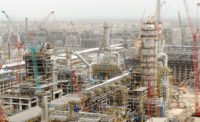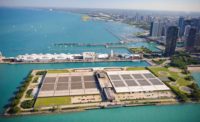Base isolation is a method for moderating the effects of earthquakes on buildings. Isolator devices (either elastic or sliding) are installed between the foundation and the building superstructure. The accompanying slide show looks at the ten largest base-isolated buildings in the world, measured by total floor area.
"The use of base isolation as seismic protection for buildings, bridges and industrial facilities continues to grow, but has done so more robustly internationally than in the U.S.," says Ronald Hamburger, Senior Principal with Simpson Gumpertz & Heger, a leading seismic engineering firm.
Not surprisingly, Japan, the most seismically active country, employs it most extensively, with 4,100 base-isolated commercial and institutional buildings as of December 2015, according to the Japan Society of Seismic Isolation. "Japan looks at base isolation as a primary option," says Konrad Eriksen, President of Dynamic Isolation Systems Inc., a leading designer and manufacturer of isolators. "In the Japanese residential market, prospective condo owners will pay a premium for a base-isolated building compared to a conventional building," says Gordon Wray, associate principal at Degenkolb Engineers, another prominent seismic engineering firm.
Turkey, another very seismically active country, is also firmly committed to base-isolation methodology. Notably, it has embarked on a $13.6-billion program to build numerous large modern hospitals, most of which will be base-isolated. In addition, major bridges and viaducts have also been protected in this fashion.
One notable project under construction in Turkey is the Ikitelli Integrated Health Campus in Istanbul. The 2,330-bed main hospital building there is expected to contain 2,000 isolators. It is a public-private partnership being developed by Istanbul PPP Sağlık Yatırım A.Ş. When completed, it is expected to be the largest base-isolated building in the world.
Other countries pushing base isolation include China, New Zealand, Chile, Peru, Colombia and Ecuador. In contrast, "in the U.S., seismic isolation is used relatively infrequently," according to Hamburger. "In recent years, the inaccurate perception that other structural systems, including energy-dissipated moment frames, or buckling-restrained braced frames, can provide similar protection at lower first cost has slowed the growth of this technology in the U.S."
"In the U.S., seismic resilience is taken for granted because of the recent infrequency of earthquakes and several decades of good building codes," says Wray. "Modern buildings have performed well in recent earthquakes (few collapses), although we have not yet experienced a code-level earthquake in a densely populated area in 23 years. I believe that many building owners have an expectation of operational performance, when typical code buildings are designed only to protect life-safety."
Seismic-isolation technologies fall into two categories: elastomeric and sliding systems. Elastomeric isolation systems consist of natural rubber; natural rubber with lead cores to dissipate energy; and high-damping rubber, consisting of blends of natural and synthetic compounds. Sliding systems generally include flat sliders, typically used in combination with elastomeric bearings and friction pendulum devices. Within the friction pendulum category there are a series of different designs, including the original system that employed a single curved dish and sliding element; a double pendulum, in which two curved dish surfaces are employed; and a triple pendulum employing three such surfaces. "The triple pendulum system reduces the size of the isolator while increasing its effectiveness," says Farzad Naeim, a prominent structural engineer and former president of the Earthquake Engineering Research Institute.
Elastomeric bearings were first used on bridges in the 1950s and were found to be an improvement over mechanical bearings, which suffered from corrosion, according to Eriksen. Friction pendulum bearings were developed in the late 1980s. "Friction pendulum bearings dominate applications in the U.S., in some other important markets like Turkey, and most applications in certain types of structures worldwide (offshore oil platforms, LNG tanks, large bridges, hospitals)," says Michael Constantinou, professor of civil, structural and environmental engineering at the State University of New York at Buffalo.
"Elastomeric systems perform best in large buildings, which have large axial loads," explains Wray. "Sliding systems perform well for both large and small axial loads (large and small buildings). The behavior of sliding systems under high-frequency vertical acceleration continues to be studied."
Deformation in a building during a large earthquake is inevitable. "Using conventional lateral force resisting systems, the deformation is distributed up the height of the building among many beams, columns, connections, braces, or shear walls," comments Wray. In comparison, "using base isolation, (nearly) all of the building deformation is concentrated at the isolation plane, limiting damage up the height of the building. The magnitude of the displacement can be predicted with more certainty than the individual deformations among hundreds or thousands of individual components of a lateral system."
"Of all the seismic protection technologies presently available, seismic isolation offers the most effective protection against damage or loss of function following strong shaking," says Hamburger. "Other structural technologies allow transmission of the motion into the structure, where its energy is dissipated either through damage to the structural elements, or through more benign energy dissipation mechanisms. Regardless, structures employing these other technologies experience greater motion and as a result more damage than do isolated structures."
The evolution and spread of base isolation is influenced by many players. "Governments have played a role in funding research to develop these technologies, including Natonal Science Foundation-funded centers such as the Pacific Earthquake Engineering Research center at UC Berkeley and the Multidisciplinary Center for Earthquake Engineering Research at the State University of New York at Buffalo," says Constantinou. "Insurance agencies (and owners) have not yet taken into consideration the reduced risk of damage for a seismically isolated structure. This may change following the work of the U.S. Resiliency Council on rating building performance."
The USRC membership includes all the major professional organizations in earthquake and structural engineering, structural engineering firms, architectural firms, contractors, and hardware and software suppliers. The USRC rating system rates buildings from one to five stars for each of three criteria: safety, damage and recovery. "While many lateral systems can provide high ratings for safety, base-isolated buildings provide the greatest opportunity to achieve high ratings for damage and recovery," says Wray.
"The USRC will certify raters and review ratings after they are submitted, similar to the USGBC's LEED ratings for sustainability," says Ronald Mayes, USRC executive director and co-founder. "The rating is a different way of specifying what an owner's performance expectations are for a building. I think it will become a powerful tool." The rating system launched in December, 2015. One building has been rated so far, with 18 more in process, according to Mayes.
"The structural engineering community in the past has done a poor job of communicating what a code-designed building delivers, as attested by the performance of modern buildings in the 2011 Christchurch New Zealand earthquake, where more than 50% of the modern buildings in the central business district delivered life-safety performance but had to be demolished after the earthquake," adds Mayes.
"The Insurance industry has done little to encourage the use of seismic isolation, and it could be said that offering an earthquake mitigation alternative to developing earthquake-resistant structures, actually provides a disincentive," says Hamburger. "The primary insurance benefit the owner of a seismically isolated structure obtains is through an ability to purchase greatly reduced levels of protection. Some owners have chosen to use base isolation as their earthquake insurance of choice, as any damage that may occur is well below current deductibles. In addition, base isolation provides business continuity, something that is very difficult to cover with insurance."
The order of the slideshow accompanying this article was updated on July 27, 2017 to reflect new information.














Post a comment to this article
Report Abusive Comment